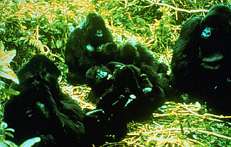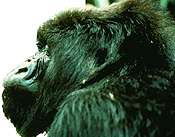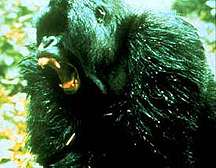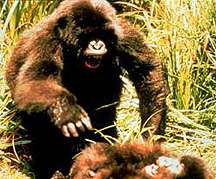


|
Social Behavior
Lorna Anness, a Karisoke researcher,
note taking
in the rain wrote, "How close they get surprised me--I was
shocked. And their tolerance--a mother would allow an infant to come right up and touch
you."
Relationships within the [gorilla] group are very important. For instance, one day
Puck, an adult female, and her son Cantsbee, a young blackback, were settling in to look
for nest sites when it started to rain. Puck sat next to Intwali her two-year-old
daughter, and Simba in a good position well out of the downpour. Cantsbee came along,
staring at Simba, and moving closer and closer. Simba gave a slow pig-grunt at Cantsbee,
but then Puck pig-grunted at Simba, while Cantsbee sidled even closer. Simba and Puck
continued pig-grunting while Cantsbee slowly but surely pushed Simba out of the nest. He
probably never would have tried to displace her if he had not known that Puck would back
him up Schaller, 1989.
If this were the best of worlds, the sheer natural beauty of the animal would have
sufficed as argument. But the Africans didn't even know whether they were beautiful or
impressive--they'd never seen them [the gorillas]. When we did surveys in the 1970s, more
than half the local population could not provide a single adjective of description. They
lived in the shadow of these volcanoes and had no idea what the gorillas were like. So,
they would flock to the films we showed, up to 3,000 people at a time from a village area,
and the response was incredible. They saw how human this animal was. They saw a family
unit; they saw a lot of maternal care--nursing, cleaning, playing, feeding; they saw
paternal affection. These films did not show King Kong bursting through the bushes. Bill Weber, Assistant Director of Conservation, The
New York Zoological Society.
 Family Groups Primates, in general, are very social animals, and mountain gorillas are no
exception. They live in small family groups consisting of varying numbers of males,
females, infants, and juveniles. Each group is led by a dominant male gorilla. The
dominant silverback protects his group and leads in the
search for food. In most monkey populations, the females stay with their family, while the
males leave their groups at adolescence. In effect, mothers, daughters, sisters, and
grandmothers stay together in family groups. A different social structure emerges among
gorillas--females leave their family and join other groups. Above
left: This family group reached a membership of thirty-five,
including four silverbacks. Photo: Courtesy of the Dian Fossey Gorilla Fund Family Groups Primates, in general, are very social animals, and mountain gorillas are no
exception. They live in small family groups consisting of varying numbers of males,
females, infants, and juveniles. Each group is led by a dominant male gorilla. The
dominant silverback protects his group and leads in the
search for food. In most monkey populations, the females stay with their family, while the
males leave their groups at adolescence. In effect, mothers, daughters, sisters, and
grandmothers stay together in family groups. A different social structure emerges among
gorillas--females leave their family and join other groups. Above
left: This family group reached a membership of thirty-five,
including four silverbacks. Photo: Courtesy of the Dian Fossey Gorilla Fund
 Since gorillas are highly social
animals, they try to defend one another when danger threatens. For example, poachers
trying to get a baby gorilla often have to kill the dominant silverback and mother first.
The death of one animal also has an effect on many others. In particular, when the
dominant silverback of a family group dies or is killed by disease, accident, or poachers,
the family group may be severely disrupted. The large family group may split into two or
more smaller groups. When a new silverback takes control of a family group, he may kill
all of the infants of the dead silverback. This practice of infanticide is seen in various
monkeys, prairie dogs, and lions (to name a few animals). It is an effective reproductive
strategy in that the new male conceives progeny that perpetuate his genes. In stable
peaceful groups, there is no apparent evidence of infanticide. Photo: Courtesy of the Dian Fossey Gorilla
Fund Since gorillas are highly social
animals, they try to defend one another when danger threatens. For example, poachers
trying to get a baby gorilla often have to kill the dominant silverback and mother first.
The death of one animal also has an effect on many others. In particular, when the
dominant silverback of a family group dies or is killed by disease, accident, or poachers,
the family group may be severely disrupted. The large family group may split into two or
more smaller groups. When a new silverback takes control of a family group, he may kill
all of the infants of the dead silverback. This practice of infanticide is seen in various
monkeys, prairie dogs, and lions (to name a few animals). It is an effective reproductive
strategy in that the new male conceives progeny that perpetuate his genes. In stable
peaceful groups, there is no apparent evidence of infanticide. Photo: Courtesy of the Dian Fossey Gorilla
Fund
Gorillas' Communication Gorillas
are active in communicating with each other by both sounds and body language. Many of
their actions reflect the hierarchy or pecking order of the group. Here a silverback makes
a "threat gesture" by turning sideways to show his size and "yawning"
to exhibit his large canine teeth.
 Gorillas are known to make over
twenty-five distinct sounds. Some of these areas follows: Gorillas are known to make over
twenty-five distinct sounds. Some of these areas follows:
- Hooting, vegetation slapping, and chest-beating, often accompanied by
strutting. This is done by rival males.
- Sharp grunting: a sign of disapproval.
- Chuckling: a sign of playfulness.
- Screaming: a sign of alarm or warning.
- High-pitched barking: a sign of curiosity.
- Roaring: a sign of aggression.
- Belching: a sign of contentment.

Gorillas also love to play. Here, two gorillas play their favorite game,
'gotcha'! Photos: Courtesy of
the Dian Fossey Gorilla Fund
[ Biology ] [
Social Behavior ] [ Habitat & Diet ]
[ Glossary
] [ Related Links
] [ References ] [
PBL Model
]
[
Home
] [ Teacher
Pages ] [
Modules &
Activities ] |

